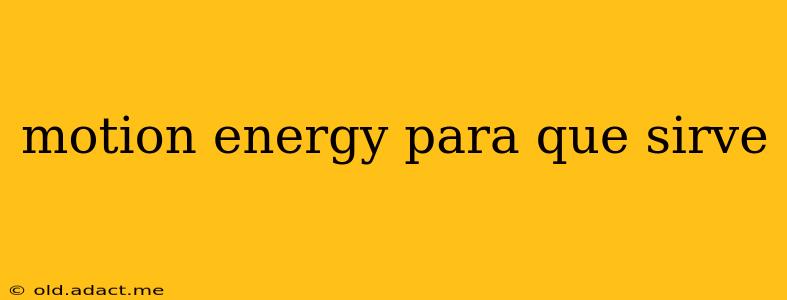Motion Energy: Uses and Applications
Motion energy, also known as kinetic energy, is the energy an object possesses due to its motion. Understanding its applications is key to appreciating its widespread importance in various fields. This energy is not a static property; it's dynamic and constantly changing depending on the object's speed and mass. Let's explore its diverse uses.
What are some examples of motion energy?
Motion energy manifests in countless ways, from the subtle movement of air molecules to the powerful force of a speeding train. Examples include:
- A rolling ball: The faster and heavier the ball, the greater its kinetic energy.
- A flowing river: The movement of water possesses kinetic energy, which can be harnessed for hydroelectric power.
- A moving car: The kinetic energy of a vehicle increases with its speed and mass.
- Wind: Wind turbines convert the kinetic energy of wind into electricity.
- A flying airplane: The airplane's movement through the air represents significant kinetic energy.
How is motion energy used in everyday life?
Motion energy isn't just a scientific concept; it's integral to our daily lives. We unconsciously utilize and benefit from it in numerous ways:
- Transportation: Cars, trains, airplanes, and bicycles all rely on motion energy to move.
- Electricity generation: Hydroelectric dams and wind turbines harness the motion energy of water and wind to produce electricity.
- Manufacturing: Many industrial processes utilize moving parts, with their kinetic energy driving machinery and production lines.
- Recreation: Activities like cycling, skateboarding, and skiing all involve motion energy.
What are the different forms of motion energy?
While the term "motion energy" broadly encompasses all energy due to movement, it's helpful to consider different forms:
- Translational kinetic energy: This is the energy of an object moving in a straight line. Think of a car driving down a road.
- Rotational kinetic energy: This is the energy of an object rotating around an axis. Imagine a spinning top or a rotating wheel.
- Vibrational kinetic energy: This is the energy associated with the back-and-forth movement of atoms and molecules, contributing to thermal energy (heat).
Can motion energy be converted into other forms of energy?
Yes, absolutely! This is a fundamental principle of physics. Kinetic energy can be transformed into other forms of energy, such as:
- Electrical energy: As mentioned earlier, wind turbines and hydroelectric dams convert kinetic energy into electricity.
- Thermal energy (heat): Friction converts kinetic energy into heat; think of rubbing your hands together.
- Potential energy: A ball thrown upwards converts its kinetic energy into gravitational potential energy as it rises.
What are the applications of motion energy in different industries?
Motion energy plays a critical role in various industries:
- Renewable energy: The most significant application is in generating clean energy from wind and water.
- Automotive: Understanding motion energy is crucial for designing fuel-efficient and safe vehicles.
- Aerospace: Efficient flight relies heavily on managing the kinetic energy of aircraft.
- Manufacturing: Motion energy powers machinery and drives production processes.
In conclusion, motion energy is a fundamental concept with far-reaching implications. Its understanding and harnessing are vital for technological advancements, sustainable energy solutions, and our everyday lives. From powering our vehicles to generating electricity, kinetic energy is a dynamic force shaping our world.
